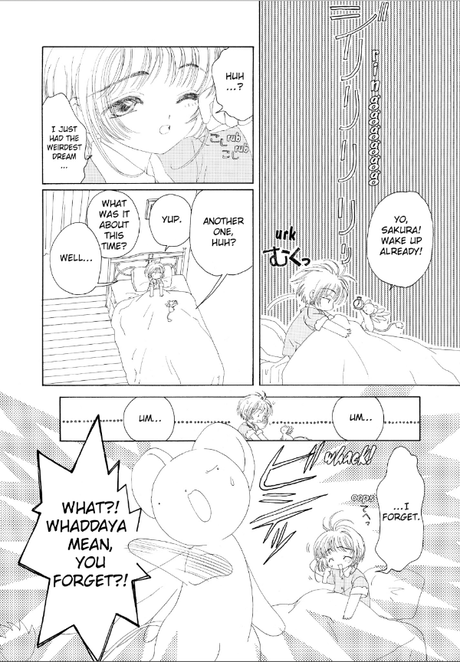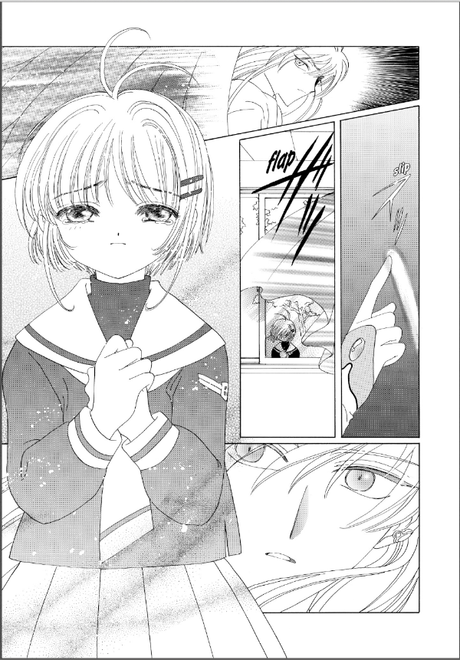Cardcaptor Sakura is hardly an unknown series, yet despite being currently licensed in the US (both in anime and manga form) it seems to fade into the background when people talk about magical girl shows or when newcomers talk about discovering shows for the first time. It’s old enough to have influenced many stories after it — on both sides of the Pacific — but there are still a number of things that CCS did which remain unique; the series has managed to age quite well.
For many magical girl series, magic is a gift given to accomplish a specific task (find these X, defeat Y) and the girl loses her magic at the end of the series — it’s a means to an end and often a metaphor for growing up. This isn’t true for every series of course — Sailor Moon and several Pretty Cure series defy it — but it’s a common enough idea that even when I come across webcomics with older magical girls (which have been in vogue for the past couple of years now) they still follow many of these same traditions. Most magical girls start without a lick of magic as well, though sometimes they’ll have a vague, prophetic-like ability before they gain their powers which then never crop up again in the series. (It’s more common to see girls already having and retaining powers in “magical girl” sister genre, “cute witch”) Again, this is a tool a girl has only for a short period of time.
CCS defies this. Sakura has a very small amount of magic before the series begins. She doesn’t realize it, but her brother and father know that she’s been reacting to ghosts around her for years. The magic is enough to let her open the book where the magician Clow Reed has stored his cards; the guardian of the book, Kero, remarks this must mean Sakura has the potential to do even more. As the story starts she uses the old magic created by Clow to recapture the scattered cards, but as the story goes on her own separate powers increase as she grows more clever in using them. This is not a story about a girl being used; this is a story about a girl growing into her own power, where her most powerful spell is being able to pick herself back up, wipe her tears away, and remain confident in what she can do.

The story is more than happy to let Sakura’s card collecting and other plots take the backseat and have the rest of Sakura’s life be the focus, especially in the second half. While a good chunk of this is focused on the various crushes of the whole cast, everyone from Sakura’s family to her classmates are well-defined characters by the end, each cute in their own way. Clamp has almost outdone themselves here with multiple BL and yuri crushes, although the series also manages to have a whopping four relationships with varying age-gaps. Even after multiple re-reads some of those relationships still don’t sit very well with me, but many of the other relationships, romantic and platonic, are quite sweet and genuine. It’s outright stated that Yuki and Toya’s love for each other is romantic (the series also isn’t afraid to let characters have multiple crushes and relationships) and even Tomoyo’s crush on Sakura seems to defy Class-S tropes by not being presented as something Tomoyo will grow out of, but rather as a startlingly mature view on love. This is further corroborated by her mother’s crush on Sakura’s own mother. While neither crush is reciprocated and Tomoyo’s mother does in fact marry, it seems as if she’s divorced — one of many quiet details in the series that adds depth to what at first looks like only fluff.
The art however is pure fluff, and utterly adorable and charming in every frame. It’s amusing that Clamp eschews the usual magical girl transformation sequence in favor of being able to change Sakura’s outfits every time — outfits that are still favorites of cosplayers and fan-artists even today. The series proves that they can do more than design a pretty look though, since the paneling in the comic flows fantastically well and you can see the thought put into each individual panel. They never seem to struggle with keeping conversations looking interesting as they bounce between character to character in each shot, letting the body language and framing change each time. They also strike a good balance between having simple backgrounds and not over-compensating for this with an over-abundance of screentones (a style which admittedly became more popular in the years after CCS). You can see them become more and more ambitious with this framing as the series goes on, a lovely compliment to seeing Sakura grow more confident within the story. Clamp also becomes very skilled at using negative space to highlight an unusually important line without being over-dramatic.

Even after multiple rereads of the series I still find something new to be charmed by every time, and maintain that it’s a great series for kids and adults alike. It’s never too scary or stressful for a child to read, even if Sakura fails many times in the story and comes back and faces down an impertinent card a second time. There are enough ideas presented in-between the lines for an older fan to enjoy on another level. In some ways, the final reveals makes the story feel “too safe” in retrospect, but it never diminishes the fact that Sakura grew and became stronger because of her adventures, something to be celebrated. It’s a bit sad that the next time “Sakura” appears in a Clamp work is in Tsubasa Reservoir Chronicles, where the roles have been flipped and rival Syaoran is now the hero and Sakura has very few moments to affect the plot or her life. Looking back, these days I’m more tempted to recommend earlier Clamp works than later ones. Nearly everything is in print, and there’s simply a certain cohesion and liveliness that Cardcaptor Sakura has in spades that newer Clamp series seem to have lost.
Missed it? Find the manga at Dark Horse Comics and the anime at NIS America and Crunchyroll.

